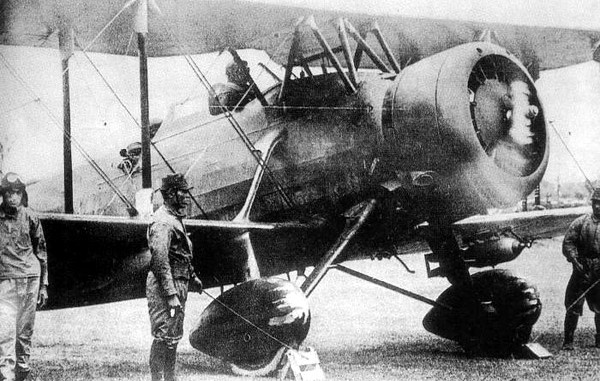
The D1A was produced in two variants, the D1A1 (Navy Type 94 Carrier Bomber), and the D1A2 (Navy Type 96 Carrier Bomber, sometimes referred to as the D2A.)
The D1A came out of the Imperial Japanese Navy's need for an advanced carrier-based dive bomber, and in late 1934 the IJN ordered the finalisation of the Aichi AB-9 design which was produced as the early model D1A1. However, the D1A1 was not designed by Aichi Tokei Denki Kabushiki Kaisha aircraft company, but by Ernst Heinkel Flugzeugwerke at the request of the Aichi company. The initial version designed by Heinkel was the He 50, a similar model equipped with floats instead of landing gear. The subsequent model, the He 66 was provided to Aichi who immediately began production of it as the D1A1.
The design of the D1A, based on the Heinkel He 66, an export model of the He 50, was designed as a biplane constructed of metal, with a fabric covering, a fixed landing gear and a conventional type tail landing skid. Original models had 365 kW (490 hp) engines and it was not until later models that more powerful 433 kW (580 hp) engines were included in the construction.
-------------------------------------
Aichi D1A (liittoutuneiden raportointinimi Susie) oli Aichi Kōkūkin valmistama kaksitasoinen kaksipaikkainen syöksypommittaja, jota käytti keisarillisen Japanin laivaston ilmavoimat toisessa maailmansodassa vuoteen 1942 asti. Sen aseistuksena oli kolme 7,7 mm kevyttä konekivääriä, joista yksi taka-ampumossa. Koneen pommikuorma oli enimmillään 310 kg koneen ulkopuolisissa ripustimissa.
Konetyyppi oli Tyynenmeren sodassa vain koulutuskäytössä, mutta Kiinan-Japanin sodassa kuitenkin laajalti hyökkäystehtävissä. A1-tyypin tuotanto määrättiin vuonna 1934. Siinä oli 580 hevosvoiman (433 kW) tehoinen Nakajima Kotobuki -tähtimoottori. Parannettua A2-mallia valmistettiin enemmän, sekä se oli varustettu tehokkaammalla Hikari -moottorilla.

Tämän tyypin niin kutsuttu esi-isä oli saksalaisten Heinkel He 66, alkujaan Heinkel He 50.
General characteristics
Crew: 2: pilot and gunner
Length: 9.3 m
Wingspan: 11.4 m
Height: 3.41 m
Wing area: 34.7 m²
Empty weight: 1,516 kg
Loaded weight: 2,500 kg
Max. takeoff weight: 2,610 kg
Powerplant: 1 × Nakajima Hikari 1 nine-cylinder radial engine, 730 hp (545 kW)
Maximum speed: 309 km/h
Range: 927 km
Service ceiling: 6,980 m
Rate of climb: 6.37 m/s
Wing loading: 72.0 kg/m²
Power/mass: 0.22 kW/kg
Armament
Guns: 2× fixed 7.7 mm Type 92 mg, + 1× flexible 7.7 mm Type 92 mg
Bombs: 1× 250 kg bomb under fuselace + 2×30 kg bombs under wings
Operational history
The D1A was primarily used in the Second Sino-Japanese War and up to the time Japan entered World War II in 1941. At the beginning of the Pacific War, all of the remaining D1A1s were decommissioned and most of the D1A2s were retired from the front lines and served primarily in training units. The exception was 68 of the D1A2 model that operated as a second-line support until being retired in 1942.
Operators
Imperial Japanese Navy Air Service
Manchukuo Imperial Navy
D1A1 Type 94
Powered by 433 kW (580 hp) Nakajima Kotobuki 2 Kai 1 or Kotobuki 3 radial engines; 162 built.
D1A2 Type 96 (Sometimes referred to as the D2A)
Improved version fitted with spatted wheels and a higher powered Nakajima Hikari 1 engine; 428 built.
AB-11
Proposed development with retractable undercarriage. Not built.
Ei kommentteja:
Lähetä kommentti
Kaikenlaiset kommentit ovat tervetulleita.